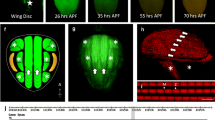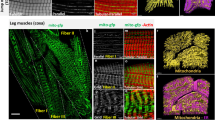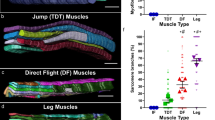Abstract
Stretch activation (SA) is a fundamental property of all muscle types that increases power output and efficiency, yet its mechanism is unknown. Recently, studies have implicated troponin isoforms as important in the SA mechanism. The highly stretch-activated Drosophila IFMs express two isoforms of the Ca2+-binding subunit of troponin (TnC). TnC1 (TnC-F2 in Lethocerus IFM) has two calcium binding sites, while an unusual isoform, TnC4 (TnC-F1 in Lethocerus IFM), has only one binding site. We investigated the roles of these two TnC isoforms in Drosophila IFM by targeting RNAi to each isoform. IFMs with TnC4 expression (normally ~90 % of total TnC) replaced by TnC1 did not generate isometric tension, power or display SA. However, TnC4 knockdown resulted in sarcomere ultrastructure disarray, which could explain the lack of mechanical function and thus make interpretation of the influence of TnC4 on SA difficult. Elimination of TnC1 expression (normally ~10 % of total TnC) by RNAi resulted in normal muscle structure. In these IFMs, fiber power generation, isometric tension, stretch-activated force and calcium sensitivity were statistically identical to wild type. When TnC1 RNAi was driven by an IFM specific driver, there was no decrease in flight ability or wing beat frequency, which supports our mechanical findings suggesting that TnC1 is not essential for the mechanical function of Drosophila IFM. This finding contrasts with previous work in Lethocerus IFM showing TnC1 is essential for maximum isometric force generation. We propose that differences in TnC1 function in Lethocerus and Drosophila contribute to the ~40-fold difference in IFM isometric tension generated between these species.








Similar content being viewed by others
References
Agianian B, Krzic U, Qiu F, Linke WA, Leonard K, Bullard B (2004) A troponin switch that regulates muscle contraction by stretch instead of calcium. Embo. J. 23:772–779
Bullard B, Pastore A (2011) Regulating the contraction of insect flight muscle. J. Muscle. Res. Cell. Motil .32:303–313. doi:10.1007/s10974-011-9278-1
Burkart C et al (2007) Modular proteins from the Drosophila sallimus (sls) gene and their expression in muscles with different extensibility. J. Mol. Biol. 367:953–969
Card G, Dickinson M (2008) Performance trade-offs in the flight initiation of Drosophila. J. Exp. Biol. 211:341–353
Collins JH (1991) Myosin light chains and troponin C: structural and evolutionary relationships revealed by amino acid sequence comparisons. J. Muscle. Res. Cell. Motil. 12:3–25
Cullen MJ (1974) The distribution of asynchronous muscle in insects with special reference to the Hemiptera: an electron microscope study. J. Entomol. 49A:17–41
Dickinson MH et al (1997) Phosphorylation-dependent power output of transgenic flies: an integrated study. Biophys. J. 73:3122–3134
Esch H, Goller F, Heinrich B (1991) How do bees shiver. Naturwissenschaften. 78:325–328. doi:10.1007/Bf01221422
Farman GP, Miller MS, Reedy MC, Soto-Adames FN, Vigoreaux JO, Maughan DW, Irving TC (2009) Phosphorylation and the N-terminal extension of the regulatory light chain help orient and align the myosin heads in Drosophila flight muscle. J. Struct. Biol. 168:240–249
Fukuda N, Granzier HL (2005) Titin/connectin-based modulation of the Frank–Starling mechanism of the heart. J. Muscle. Res. Cell. Motil. 26:319–323. doi:10.1007/s10974-005-9038-1
Gagne SM, Li MX, McKay RT, Sykes BD (1998) The NMR angle on troponin C. Biochem. Cell. Biol. 76:302–312
Granzier HLM, Wang K (1993) Interplay between passive tension and strong and weak binding cross-bridges in insect indirect flight muscle. J. Gen. Physiol. 101:235–270
Heinrich B (1996) The thermal warriors: strategies of insect survival. Harvard University Press, Cambridge
Herranz R, Diaz-Castillo C, Nguyen TP, Lovato TL, Cripps RM, Marco R (2004) Expression patterns of the whole troponin C gene repertoire during Drosophila development. Gene. Expr. Patterns. 4:183–190. doi:10.1016/j.modgep.2003.09.008
Hyatt CJ, Maughan DW (1994) Fourier analysis of wing beat signals: assessing the effects of genetic alterations of flight muscle structure in Diptera. Biophys. J. 67:1149–1154
Iwamoto H, Inoue K, Yagi N (2010) Fast X-ray recordings reveal dynamic action of contractile and regulatory proteins in stretch-activated insect flight muscle. Biophys. J. 99:184–192
Josephson RK, Malamud JG, Stokes DR (2000) Asynchronous muscle: a primer. J. Exp. Biol. 203:2713–2722
Josephson RK, Malamud JG, Stokes DR (2001) The efficiency of an asynchronous flight muscle from a beetle. J. Exp. Biol. 204:4125–4139
Katzemich A et al (2012) The function of the M-line protein obscurin in controlling the symmetry of the sarcomere in the flight muscle of Drosophila. J. Cell. Sci. 125:3367–3379. doi:10.1242/jcs.097345
Krzic U, Rybin V, Leonard KR, Linke WA, Bullard B (2010) Regulation of oscillatory contraction in insect flight muscle by troponin. J. Mol. Biol. 397:110–118. doi:10.1016/j.jmb.2010.01.039
Lakey A, Labeit S, Gautel M, Ferguson C, Barlow DP, Leonard K, Bullard B (1993) Kettin, a large modular protein in the Z-disc of insect muscles. EMBO. J. 12:2863–2871
Lehman W, Galinska-Rakoczy A, Hatch V, Tobacman LS, Craig R (2009) Structural basis for the activation of muscle contraction by troponin and tropomyosin. J. Mol. Biol. 388:673–681. doi:10.1016/j.jmb.2009.03.060
Lehmann FO, Dickinson MH (1997) The changes in power requirements and muscle efficiency during elevated flight force production in the fruit fly. Drosophila. J. Exp. Biol. 200:1133–1143
Linari M, Reedy MK, Reedy MC, Lombardi V, Piazzesi G (2004) Ca-activation and stretch-activation in insect flight muscle. Biophys. J. 87:1101–1111
McKillop DF, Geeves MA (1993) Regulation of the interaction between actin and myosin subfragment 1: evidence for three states of the thin filament. Biophys. J. 65:693–701
Moss RL, Fitzsimons DP (2002) Frank–Starling relationship: long on importance, short on mechanism. Circ. Res. 90:11–13
Perz-Edwards RJ et al (2011) X-ray diffraction evidence for myosin-troponin connections and tropomyosin movement during stretch activation of insect flight muscle. Proc. Natl. Acad. Sci. USA. 108:120–125. doi:10.1073/pnas.1014599107
Pringle JWS (1978) Stretch activation of muscle: function and mechanism. Proc. R. Soc. Lond. B. 201:107–130
Pringle JWS (1981) The Bidder Lecture, 1980 the evolution of fibrillar muscle in insects. J. Exp. Biol. 94:1–45
Qiu F, Lakey A, Agianian B, Hutchings A, Butcher GW, Labeit S, Bullard B (2003) Troponin C in different insect muscle types: identification of an isoform in Lethocerus, Drosophila and Anopheles that is specific to asynchronous flight muscle in the adult insect. Biochem. J. 371:811
Ramanath S, Wang Q, Bernstein SI, Swank DM (2011) Disrupting the myosin converter-relay interface impairs Drosophila indirect flight muscle performance. Biophys. J. 101:1114–1122. doi:10.1016/j.bpj.2011.07.045
Reedy MC, Beall C (1993) Ultrastructure of developing flight muscle in Drosophila. I. Dev. Biol. 160:443–465
Reedy MC, Beall C, Fyrberg E (1989) Formation of reverse rigor chevrons by myosin heads. Nature. 339:481–483. doi:10.1038/339481a0
Rome LC et al (1999) Trading force for speed: why superfast crossbridge kinetics leads to superlow forces. Proc. Natl. Acad. Sci. USA. 96:5826–5831
Rosenfeld SS, Taylor EW (1985) Kinetic studies of calcium binding to regulatory complexes from skeletal muscle. J. Biol. Chem. 260:252–261
Squire JM et al (2006) The myosin filament superlattice in the flight muscles of flies: a-band lattice optimisation for stretch-activation? J. Mol. Biol. 361:823–838. doi:10.1016/j.jmb.2006.06.072
Swank DM (2012) Mechanical analysis of Drosophila indirect flight and jump muscles. Methods. 56:69–77. doi:10.1016/j.ymeth.2011.10.015
Swank DM, Knowles AF, Suggs JA, Sarsoza F, Lee A, Maughan DW, Bernstein SI (2002) The myosin converter domain modulates muscle performance. Nat. Cell. Biol. 4:312–317
Swank DM, Kronert WA, Bernstein SI, Maughan DW (2004) Alternative N-terminal regions of Drosophila myosin heavy chain tune muscle kinetics for optimal power output. Biophys. J. 87:1805–1814
Syme DA, Josephson RK (1995) Influence of muscle length on work from trabecular muscle of frog atrium and ventricle. J. Exp. Biol. 198:2221–2227
Thorson J, White DCS (1983) Role of cross-bridge distortion in the small-signal mechanical dynamics of insect and rabbit skeletal muscle. J. Physiol. (Great Britain) 343:59–84
Tohtong R, Yamashita H, Graham M, Haeberle J, Simcox A, Maughan D (1995) Impairment of muscle function caused by mutations of phosphorylation sites in myosin regulatory light chain. Nature. 374:650–653
Tu MS, Dickinson MH (1996) The control of wing kinematics by two steering muscles of the blowfly (Calliphora vicina). J. Comp. Physiol. 178:813–830
Vibert P, Craig R, Lehman W (1997) Steric-model for activation of muscle thin filaments. J. Mol. Biol. 266:8–14
Wang Q, Zhao C, Swank DM (2011) Calcium and stretch activation modulate power generation in Drosophila flight muscle. Biophys. J. 101:2207–2213. doi:10.1016/j.bpj.2011.09.034
Wang Q, Newhard CS, Ramanath S, Sheppard D, Swank DM (2014) An embryonic myosin converter domain influences Drosophila indirect flight muscle stretch activation, power generation and flight. J. Exp. Biol. 217:290–298. doi:10.1242/jeb.091769
Wray JS (1979) Filament geometry and the activation of insect flight muscles. Nature. 280:325–326
Yang C, Ramanath S, Kronert WA, Bernstein SI, Maughan DW, Swank DM (2008) Alternative versions of the myosin relay domain differentially respond to load to influence Drosophila muscle kinetics. Biophys. J. 95:5228–5237
Zumstein N, Forman O, Nongthomba U, Sparrow JC, Elliott CJ (2004) Distance and force production during jumping in wild-type and mutant Drosophila melanogaster. J. Exp. Biol. 207:3515–3522
Acknowledgments
We thank Friederike Thiele (an Erasmus student, Department of Biology, University of York) for help with fluorescence and electron microscopy. We also thank Drs Upendra Nongthomba and John Sparrow for the UH3-GAL4 fly line, and Dr. John Sparrow for performing fly crosses. This work was supported by National Institutes of Health R01 AR055611 to D.M.S. A.K. was supported by a European Union FP6 Network of Excellence grant, MYORES. C.C.E. was supported by NIGMS Biomolecular Science and Engineering Training Grant 5T32GM067545.
Author information
Authors and Affiliations
Corresponding author
Additional information
Catherine C. Eldred and Anja Katzemich have contributed equally to this work.
Rights and permissions
About this article
Cite this article
Eldred, C.C., Katzemich, A., Patel, M. et al. The roles of troponin C isoforms in the mechanical function of Drosophila indirect flight muscle. J Muscle Res Cell Motil 35, 211–223 (2014). https://doi.org/10.1007/s10974-014-9387-8
Received:
Accepted:
Published:
Issue Date:
DOI: https://doi.org/10.1007/s10974-014-9387-8




